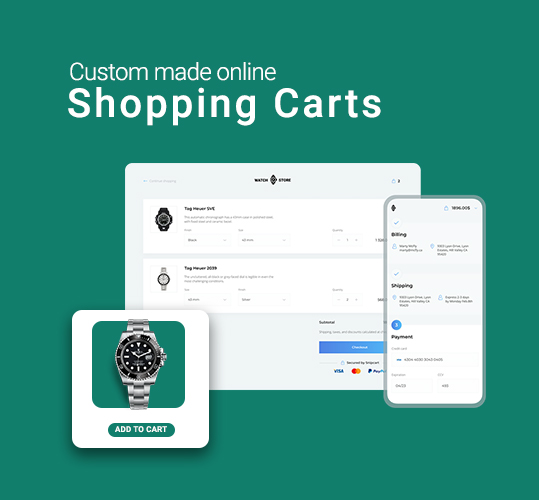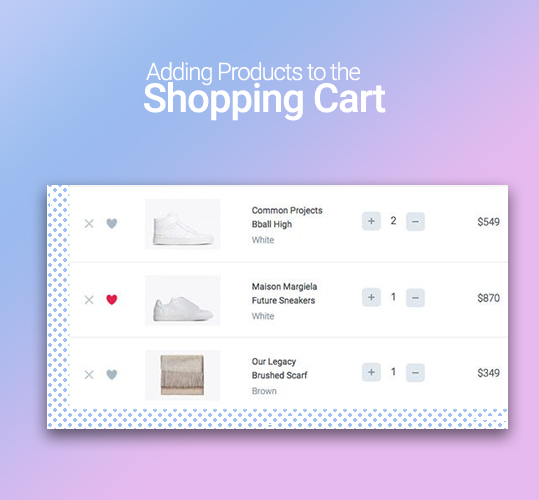With the increase in the coronavirus affected cases, there is a whopping rise in online shopping. All thanks to the convenience of speedy internet connection. According to Statista, there is an exceptional rise in the global retail traffic between January 2019 and June 2020 that exceeds even the traffic peaks in the holiday season. As per the research, the retail platforms generated a massive 22 billion visits alone in the month of June 2020 which was 16.07 billion in January 2020. This ratio is self-efficient to showcase the importance of online shopping in our everyday lives. Unlike the traditional brick and mortar store shopping, there are many more hurdles in the sales cycle. One of the frequent problems faced by ecommerce owners is that the people who visit an online shopping site may not necessarily be the buyers of that product. Therefore, it becomes essential for online store owners to widen the purchase rate.
To deal with such issues, an online shopping cart is mandatorily integrated into all ecommerce websites/ stores. If you are comparatively new to the online selling market, you might want to know how these online shopping carts work. In this blog post, we are about to discuss how shopping carts actually work. But, before that, lets us start from the basics.
What are shopping carts?
Online shopping cart is software that simplifies the purchase of a product or a service. It accepts payments from the customers and manages the transfer of that information to the payment processor, online seller, and other associated bodies. In other words, an online shopping cart resembles a physical shopping trolley you find in the malls; but with more advanced features and not to mention, the former is a virtual feature integrated into the online shopping websites.
In the online shopping carts, people can put all their to-be-purchased products, review them, choose to purchase or delete them from the cart if needed. What makes online shopping carts more advanced is that you can organize the products in an online shopping cart in the form of a list and get detailed information about the prices of each product, the additional charges (if any), and the total sum. This means that they no longer have to manually add the prices of the products to check the total billing amount. In a nutshell, it is a place that prepares the purchasing of shopper’s to-buy products. After getting the detailed pricing of the products, the shoppers can decide to proceed or delete the added products in the cart.
What are the various types of online shopping carts?
There are mainly three categories of online shopping carts, they are:
1. Readymade online shopping carts
These kind of shopping carts are generally SAAS or Software As A Service products whose features can be borrowed by subscribing to a monthly or annual plan. It is a pre-built shopping cart that lets an online seller build, host, and manage their online store. The best example of one such cart is the Builderfly Ecommerce Platform.
2. Custom made online shopping carts

As its name says, this kind of online shopping carts is custom made or bespoke. The online seller can customize the features to be availed in these online shopping carts.
3. Open source online shopping carts
The open-source online shopping carts can be described as a free version of the readymade shopping carts. However, unlike the latter, in open-source online shopping carts, the sellers get access to the source code and customize it as per their needs.
How do they work?
As an online seller, you must be well-known to the way shopping carts work, its features, and the benefits awarded. Irrespective of the type of shopping carts you choose, there is a generalized way on how these shopping carts actually work. We are making it simple for you; below is a step by step guide to show how these online shopping carts actually work.
Adding Products to the Shopping Cart

When online shoppers browse through an ecommerce website, it is the primary stage of the searching process that can potentially convert a visitor into a buyer. By proving an ‘Add to Cart’ button on every product you sell on your website, your potential customers can easily add the products they liked to the shopping carts for further review. Creating and providing an easy-to-use tool to assist customers in purchasing the products they like is the most essential step to grab their attention and motivate them to take the next step and complete the purchase.
Processing in the Cart
Integrating a user-friendly online shopping cart to a website is crucial for the customers to decide whether they actually need that particular product(s) or not. The more convenient it is to make alterations in the shopping cart, the higher the chances of shoppers being ready to complete the purchase by making the required payment. The alteration facilities provided must mainly include adding new products, deleting the selected products, changing the number of products, selecting the size of the products, altering the materials, and the list goes on. The customers must be able to carry out all these actions within a few clicks. In the cart, the total amount of the products, even after the alterations is automatically calculated in order to help the customers shop according to their budgets. When the customers click on the Checkout button, it leads them to the next step in the shopping cycle.
Purchasing
This is the checkout procedure wherein the customer must provide the personal and payment details including their name, billing address, shipping address, phone number, credit/debit card number, and other details if required. However, this information required to purchase a product, especially on a recurring basis can be quite frustrating. If you wish to avoid your customers from abandoning carts, you must provide a convenient and concise checkout process with supporting features such as the option to save addresses for future, a suggestion of automatic filling of address, various payment methods, multiple shipping options, save the payment modes, and so on. If done, the customers will be able to review their orders by simply clicking on the Submit/Complete Order button. Once the customer has reviewed their purchase, you can assure that you have converted a visitor into a customer.
Additional Purchasing
The function of an online shopping cart does not end by successfully converting a visitor into a customer. Every online seller will want to retain their already existing customers by motivating them to purchase more even after they have completed a purchase. Due to this reason, providing the customers with a Continue Shopping button along with some automated suggestions to substitute or complement their choice of products is essential. By doing so, the customers will not have to leave their shopping carts to add those products in their Orders. Moreover, many major online sellers consider up-selling and cross-selling as a great way to engage their customers.
Shopping Cart Changes in the Eleventh Hour
Online shoppers are often sceptical about the products they have chosen and are planning to invest their money on it. It is completely normal when online shoppers make last-minute changes in their orders. As an online seller, you must make sure that you make them comfortable in making such changes in their shopping carts efficiently. Let them delete or add products, or let them do any alterations they like to their shopping cart easily, even at the last second.
Conclusion
The speedy development of online businesses today makes it easier for online sellers to reach their target audience. However, it also means that online shoppers have wider options to choose products and invest their money. Therefore, it is highly important for you as an online seller to meet the various customer requirements by taking a customer-centric approach in creating the online selling platform. You must try your best to gain competitive advantages in order to attract more customers to your site as compared to your competitors. Understanding the mechanism of an online shopping cart can be of prime importance to gain such competitive advantages, boost conversion rates, ease the sales effectiveness, and curb the chances of the abandoned cart as much as possible. Remember, if you are not providing these features to your customers, there are many in the market who will and the chances of your customers leaving abandoned carts will significantly rise.







